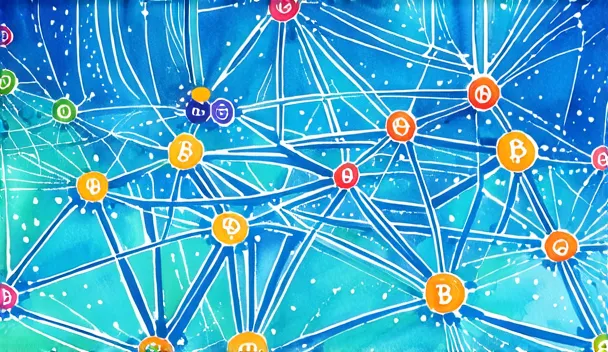What is Decentralization

Decentralization has become a buzzword in today's digital landscape, promising to revolutionize the way we interact with technology and each other.
As we increasingly rely on networks and systems that are more complex and interconnected than ever before, decentralization offers a compelling alternative to traditional top-down approaches - but what does it really mean?
Unpacking Decentralization: History, Evolution, and Fundamentals
Early Implementations and Historical Context
The concept of decentralization has been around for decades, with early implementations dating back to the 1960s.
One notable example is the ARPANET, a decentralized network developed by the US Department of Defense's Advanced Research Projects Agency (ARPA). This precursor to the modern-day internet was designed to be resilient and fault-tolerant, allowing data to be transmitted between nodes without relying on a central hub.
Another early example is the BitTorrent protocol, introduced in 2001, which enables peer-to-peer file sharing without a centralized server.
These pioneering systems laid the groundwork for the blockchain technology we know today, demonstrating the potential of decentralized networks to facilitate secure, transparent, and efficient data exchange.
From Peer-to-Peer Networks to Blockchain Technology: A Journey
The concept of decentralization has its roots in peer-to-peer (P2P) networks, where individual nodes interact with each other without the need for a central authority. One notable example is the Napster music sharing platform that emerged in the late 1990s.
This pioneering P2P network allowed users to share files directly with one another, marking a significant shift away from traditional client-server models.
Fast forward to 2008, when Satoshi Nakamoto introduced Bitcoin and blockchain technology, revolutionizing decentralization by leveraging cryptography, game theory, and distributed consensus mechanisms.
This groundbreaking innovation gave birth to a new era of decentralized networks, enabling secure, transparent, and tamper-proof transactions without the need for intermediaries.
Understanding Distributed Governance and Control Models
In a decentralized system, distributed governance and control models enable decision-making without a central authority. This is achieved through various mechanisms such as voting protocols, smart contracts, and game-theoretic designs.
In essence, these models ensure that no single entity can manipulate the network, allowing for collective ownership and management.
To illustrate this concept, consider a decentralized social media platform where content moderation decisions are made by a distributed network of users rather than a single administrator. This model enables a more democratic and transparent decision-making process, ensuring that the platform remains community-driven and resistant to censorship.
Characteristics of Decentralized Systems: Autonomy, Distribution, Inclusivity, and Interconnectedness Explained

Empowering Individual Nodes through Autonomy and Agency
In a decentralized system, individual nodes operate independently, making decisions based on their own rules and protocols. This autonomy allows each node to function as a separate entity, unencumbered by the need for centralized approval or control.
Think of it like a swarm of birds flying in formation - each bird makes its own decisions about speed, direction, and altitude, yet together they create a cohesive whole. Similarly, individual nodes in a decentralized network can make their own decisions, but still contribute to the overall harmony of the system.
This autonomy also enables agency, where each node has the power to act on its own behalf, rather than relying on a central authority for permission.
Enhancing Transparency, Security, and Trust in Decentralized Systems
Decentralized systems boast a unique trifecta of transparency, security, and trust. Transparency is elevated through open-source coding and publicly visible ledgers, such as blockchain, allowing users to track transactions and data exchanges in real-time.
This visibility fosters an environment where actions are accountable and tamper-evident, promoting trust among participants. Security is also amplified due to the distribution of data across a network of nodes, making it increasingly difficult for malicious actors to manipulate or compromise sensitive information.
For instance, imagine a digital "safe" where multiple people have keys - if one keyholder tries to access the safe without consent, others will be alerted and can intervene. This decentralized framework ensures that no single entity controls the entire system, thereby safeguarding against potential vulnerabilities.
Fostering Global Collaboration and Inclusive Decision-Making
Decentralized systems enable global collaboration by allowing individuals from diverse backgrounds to participate in decision-making processes, regardless of their geographical location. This is particularly evident in blockchain-based networks, where nodes from all over the world can validate transactions and reach a consensus without being controlled by a central authority.
The open-source nature of decentralized systems also promotes inclusivity, as anyone can contribute to the development and improvement of the network. For instance, the Linux operating system was developed through collaborative efforts from developers worldwide, demonstrating how decentralized collaboration can lead to robust and reliable software.
The Power of Decentralization: Enhanced Transparency, Improved Security, Resilience, Scalability, and Innovation

Increased Visibility and Accountability: A New Paradigm for Transparency
The decentralized nature of blockchain technology introduces a new era of transparency, where all transactions are time-stamped and recorded on a publicly accessible ledger.
This heightened visibility enables real-time tracking and monitoring, making it possible to identify potential issues before they escalate. In traditional systems, opacity often breeds mistrust and corruption; with decentralization, the open-book approach fosters accountability and encourages honest behavior.
For instance, in supply chain management, a blockchain-based system can track products from origin to delivery, reducing counterfeiting and ensuring authenticity.
As transparency increases, so does trust - and with it, the potential for more efficient, secure, and innovative applications of decentralization.
Improved Security through Distributed Networks and Consensus Mechanisms
Decentralization in blockchain technology provides a robust security framework by leveraging distributed networks and consensus mechanisms.
Unlike traditional centralized systems, where a single point of failure can compromise the entire network, decentralized systems distribute data and control across multiple nodes. This makes it increasingly difficult for malicious actors to manipulate or alter data, as they would need to compromise a majority of nodes simultaneously.
Consensus mechanisms, such as Proof of Work (PoW) or Proof of Stake (PoS), further enhance security by requiring agreement among nodes before transactions are validated and added to the blockchain. This ensures that even if an individual node is compromised, the integrity of the network remains intact.
The Future of Decentralization: Unlocking Innovation and Growth
As decentralization continues to revolutionize various industries, its potential for innovation and growth is vast.
Imagine a world where decentralized networks enable seamless data sharing across borders, fostering unprecedented collaboration among researchers, scientists, and innovators. This could lead to breakthroughs in fields like medicine, climate change, and sustainable energy.
Decentralized platforms are also enabling the rise of decentralized finance (DeFi), allowing individuals to participate in global financial markets without intermediaries.
The future of decentralization holds immense promise for unlocking innovation, driving growth, and transforming the way we live and work.
Implementing Decentralized Solutions: Overcoming Challenges, Addressing Limitations, and Ensuring Sustainable Adoption

Assessing Technical Requirements for Decentralized Systems: A Checklist
Evaluating a decentralized system's technical requirements is crucial to ensure its sustainability and scalability.
To achieve this, consider the following checklist:
Mitigating Centralization Risks in Distributed Networks: Strategies and Best Practices
As blockchain technology continues to evolve, mitigating centralization risks is crucial for ensuring the integrity and sustainability of decentralized networks.
To combat this issue, developers can implement various strategies such as decentralizing node infrastructure, promoting diversity in mining pools, and encouraging community participation in governance decisions. For instance, a decentralized network can be designed with multiple nodes operating independently, thereby reducing reliance on any single point of control.
Furthermore, implementing game-theoretic mechanisms like Byzantine Fault Tolerance (BFT) algorithms can help prevent centralization by ensuring that malicious actors are incentivized to behave honestly. By adopting these best practices, developers can create more resilient and decentralized networks, ultimately fostering a secure and sustainable blockchain ecosystem.
Fostering Sustainable Adoption through Collaborative Governance Models and Community Engagement
Decentralized solutions require more than just a robust technical framework; they necessitate collaborative governance models that facilitate community engagement.
By empowering stakeholders to participate in decision-making processes, decentralized systems can ensure sustainable adoption. A prime example is the Linux operating system, which has maintained its relevance through community-driven updates and contributions.
Similarly, blockchain-based platforms like Ethereum have implemented governance models that allow for decentralized decision-making, ensuring the network's evolution aligns with community interests.
By adopting collaborative governance models, decentralized solutions can foster a sense of ownership among stakeholders, driving long-term adoption and overcoming limitations associated with centralized systems.
Conclusion
In this comprehensive exploration, we have delved into the world of decentralization, uncovering its history, evolution, and fundamental characteristics. We've examined how decentralized systems are built on autonomy, distribution, inclusivity, and interconnectedness, and discovered the numerous benefits that come with adopting such a model.
By understanding the power of decentralization and acknowledging its challenges and limitations, we can better navigate the complexities of implementing decentralized solutions.
As we move forward, it's clear that the future of decentralization holds great promise for unlocking new frontiers in various industries and aspects of our lives. With a deeper understanding of this technology, we can harness its potential to create more open, collaborative, and equitable systems.